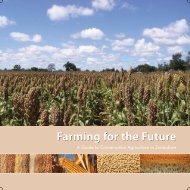Restoring the Soil - Canadian Foodgrains Bank
Restoring the Soil - Canadian Foodgrains Bank
Restoring the Soil - Canadian Foodgrains Bank
Create successful ePaper yourself
Turn your PDF publications into a flip-book with our unique Google optimized e-Paper software.
46Decision Tree Guide25. Honduras. Mucuna can also be consumed,once it has been treated to rid <strong>the</strong> bean of itsL-Dopa (which is a medicine used for treatingParkinson’s disease). Gm/ccs like cowpeas, ricebeans, mungbeans and lablab beans for lowaltitudes, and fava beans, scarlet runner beans andtarwi for higher altitudes, can be consumed without<strong>the</strong> need to take any such precautions.processing to get rid of <strong>the</strong> L-Dopa <strong>the</strong>ycontain (Photo 25). On <strong>the</strong> o<strong>the</strong>r hand,for people with Parkinson’s disease,L-Dopa is <strong>the</strong> drug of choice, so a cup ortwo of coffee each morning, made withwell-toasted mucuna seeds, can providesome relief for those Parkinson’s patientstoo poor to buy pills. If mixed half andhalf with normal coffee, <strong>the</strong> slightlydifferent taste of <strong>the</strong> mucuna coffee is notnoticeable.Very likely, mucuna’s popularity is due toits ability to control weeds. It is by far <strong>the</strong>best gm/cc species for this purpose. Thefact that farmers have given it so much useand prominence is a major indication offarmers’ priorities: reducing labor demands is very high on <strong>the</strong>ir list and manualweed control demands a lot of labor.Most mucunas are superior weed killers because <strong>the</strong>y crawl and climb aggressively.(Photo 13—only <strong>the</strong> perennial mucuna is a bushy type, but it has notbeen popular with farmers because it often fails to produce seed and it does notcontrol weeds as well.) Generally, we prefer not to use mucuna as an intercrop forthis very reason—it is too difficult to keep it from smo<strong>the</strong>ring <strong>the</strong> crop(s) withwhich it is associated. At first, program personnel and farmers who see mucunagrowing over everything in sight might fear it will become a pest, crawling overand suffocating everything. (I have seen it grow up to <strong>the</strong> top of a 20 m tall pinetree.) But it is very easy to get rid of. If mucuna is cut below <strong>the</strong> first branchesbefore it has produced viable seed, it will disappear from a field.Mucuna’s aggressiveness and ability to place its next leaf precisely where it willprevent weeds from getting any sunlight at all are probably what make it sucha superior “green herbicide.” Some people also attribute mucuna’s weed controlattributes partly to allelopathic substances in its leaves that may deter <strong>the</strong> growthof weeds. Fur<strong>the</strong>rmore, <strong>the</strong> 140 kg of N that is fixed per hectare and high levelsof organic matter production (in some cases as high as 75 MT of organic matter(green weight) per hectare each year) make it a wonderful fertilizer (Photo 12).It also decomposes quickly, like most legumes containing a high percentage ofnitrogen. When <strong>the</strong> leaves are incorporated into a moist, lowland tropical soil,<strong>the</strong>y will disappear within two to three weeks.Rapid decomposition is usually not desired, because a lot of <strong>the</strong> nitrogen will bewashed out of <strong>the</strong> soil (and into <strong>the</strong> groundwater) as a result. That is one reasonto leave <strong>the</strong> plant material on top of <strong>the</strong> soil, or bury it toge<strong>the</strong>r with <strong>the</strong> rest of<strong>the</strong> organic matter from <strong>the</strong> fallow. If <strong>the</strong> mucuna is planted with crops, we leave
















